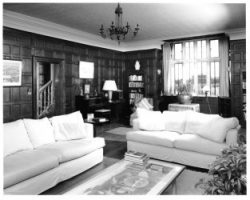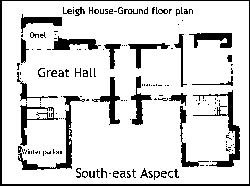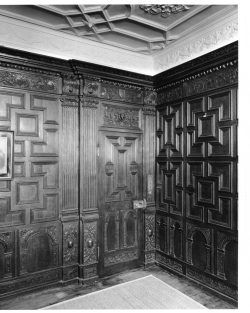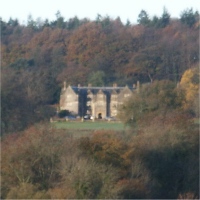LEIGH, WINSHAM, SOMERSET
Leigh is a house of gentry status, built in 1617 for Henry Henley. It is built on an 'E' plan, with wings that project forward (to the east) and also slightly to the rear. The house is of stone, of two and a half storeys, with ovolo mullions to windows and with a completely symmetrical front elevation. Inside, the original plan survives in part, and there is excellent woodwork of the original period of building. In 1633, Leigh was called
'a faire house finely sceated built by the now owner of it Mr.
Henley' (1). The house was altered in the 18th century, altered again and enlarged in the 19th, again in the 1920's or '30's, and subdivided into four in 1954. Subsequently two of these four parts have been reunited.
Contents (Click on item, or scroll down))
History
In the Middle Ages, Leigh formed a part of the estates of Ford Abbey, and was probably farmed as a grange. Following the dissolution, Leigh passed through several hands before being acquired in November 1588 as 'The Manor or Grange of Leigh' by Robert Henley, who described himself in his evidence book as a merchant of Taunton(2) . Robert Henley writes
'this Grange was bought of Wm. Deane yeoman who bought of Sr.Jno. Pollard son & heir (its probable) of Richard Pollard of Ford Esq. one of the surveyors gen of all of the lands of KH8 from whom he had a grant of Ford whereof this was
pcell'.
The property was described by him at that date (presumably by reference to the deeds) as comprising
'2 mess[uag]es 1 toft 1 barne 2 gard[ens] 2 orchards 100 [acres of arable] land, 20 [acres of] meadow 100 [acres of] pasture 40 [acres of] wood 200 [acres of] furze & heath 20 [acres of] moor, 40 [?acres of] Alders'
for which Henley paid £550.
Leigh was Henley's first major purchase; between 1576 when his buying began and ended 1613, the date of the last detailed entry in his evidence book in the year before his death, he spent over £15,000 on property, mostly in Somerset and Dorset, besides other transactions for which the full details are not recorded. He was resident at Leigh at least since 1608 (3) and it is possible that some part of the existing house incorporates remains of the house he occupied.
The present house, however, was built by his son. Henry, born around 1566, soon after inheriting from his father. He died in 1638, and the inventory of the his possessions taken on his
death, lists the contents of rooms(4). Some, but not all, of these rooms can be identified with those in the house as existing. Other inventories for the house survive for 1759(5), when the house was to be let to Robert Hanning of Combe St.Nicholas, described as gentleman, and for 1850. The house was visited by Celia Fiennes - a family connection - in 1698(6), whose brief account of the house is attached and referred to in the text.
The house was sold by the heirs of Henry Cornish Henley in 1919. Later owners included Sir George Davies (c.1920 to 1947) and a Mr. Lawley thereafter; the house was divided into four separate dwellings in 1954.
Description
The principal elevation is to the east, with services to the north and the best rooms to the south. The attic is lit by windows in gablets. Chimney stacks project shallowly on all facades; those to the-rear (west) have now been partly obscured by later additions on the lower floors. There is a two-storey porch to the front, and secondary external doors to north and south which enter staircase halls. The house has projecting bay windows facing south, giving onto the gardens and lighting the parlour and the upper end of the hall. Rainwater heads on the south and east fronts carry the date 1617.
Entrance is now into a narrow passage, hall, but the solid wall between the passage and the hall, to the south, is probably the replacement of an original, lighter screen. On the opposite side of the entrance passage is another masonry partition, with three openings - a central doorway and two deep cupboards, which may indicate the positions of service doors but which now have 18th century door cases.

The Grand Hall c.1995 |
|
 |
The hall is large, occupying the whole of the centre of the house from the line of the screens passage to the south, outside wall. It is lit by two windows - by a six-light oriel in the south wall and by another six-light window in the east front. It has original
scratch-moulded wainscot, five frames high, throughout, save for the southern part of the west wall where there is bolection panelling of c.1700. The hall is heated by a broad, 4-centred fireplace opening in its west wall.
Celia Fiennes described the hall as having two fireplaces and a large half-pace or dais; there is now no sign of the latter, nor of a second fireplace.
However, the south-west corner of the hall originally opened out into a small oriel bay, now a separate room. The 1638 inventory lists an 'oriel chamber' on the first floor, which can only be the small room over this space, while the difference in the hall panelling at this point indicates that the oriel bay was not partitioned off from the hall until the end of the century. On the ground floor, there is a thickening in the north wall of this small room, while a fireplace in the oriel chamber above shows this thickening to be for a stack. It is clear that this oriel bay was originally open to the hall, and had its own fireplace; this and the principal hall fireplace are
no doubt the two in the hall mentioned by Celia Fiennes. The 1638 inventory records two pairs of andirons - one small, and one long with brass knobs - though it is possible that both pairs furnished one fireplace; only one fire back, tongs and fire shovel are listed.
The south east wing, running south from the upper end of the hall, contains the parlour and the original principal stair (hereinafter described simply as 'the principal stair', though superseded in the 19th century by another: see below). The parlour has good panelling of early-17th century character, with pilasters and frieze, a four-centred fireplace opening, and a ribbed plaster ceiling. There is a blind window on the north, but panelling runs across the inner face and seems not to have been moved. The parlour is still well lighted, on south and east walls, and this blocking of the north window seems to be original.

The Main Staircase |

Fine panelling in the winter parlour |
The principal stair rises in a separate hall between hall and parlour, in dogleg flights to the attic floor. The flights are framed separately, with independent, paired newels, and have turned, hourglass balusters and grooved newels with acorn finials. This stair hall also contains an external door to the gardens.
At the low end of the house - to the north of the hall - the original arrangements have been altered rather more than those to the south, and are very much less clear. The room immediately north of the entrance passage is now a dining room, with a simple 18th-century plaster ceiling, but the 1638 inventory mentions two butteries, 'old' and 'new', one of which is likely to have been here. The room is now heated by a stack in the west wall, but none of the chimneypieces serving this stack on each floor is older than the 18th century, and it is possible that the stack has been added; if so, the original arrangement of this area may have been a common one of c. 1580-1620 with a passage from the rear of the screens passage, past the buttery in the low end of the central part of the house, to the service wing. Celia Fiennes describes here 'a good parlour new wanscoated', and it is therefore probable that by the end of the 17th century the original arrangements had recently been altered, the buttery already turned into a dining parlour, and the services relocated further into the north and north-west wings.
The north wing of the principal building contains two rooms divided by a secondary stair in a position corresponding to that of the principal stair in the south wing. Both of these rooms have large stacks, suggesting kitchen use, but while the fireplace in the eastern room has been inserted during the present century (see below) part of a broad, four-centred fireplace opening remains visible in the western. Celia Fiennes mentions only 'kitchen and pantrys', but the service rooms listed in the 1638 inventory are kitchen, new kitchen, brewhouse, larder house and dairy house. It is clear that one of these two rooms of the principal building is the 'new kitchen', since the inventory lists both chamber and cockloft (attic) above it - which would not be possible in the low western wing where there is no space for accommodation within the roof.
Some of these service functions must, however, have been accommodated in the lower wing to the west of the principal house. The two eastern rooms of this may be seventeenth century; they seem to have been added to the principal block, but it is also possible that their basic structure pre-dates it (they are reputedly medieval, but there is no clear evidence for this). In 1758 the service rooms listed were kitchen, still house, laundry, butler's pantry, brew house, servants' hall and housekeeper's room, but as in 1638 it is not possible to know which of the present rooms correspond to those listed.
The secondary stair is basically original, but the lower flights have been reversed in the present century in order to enlarge the room to the east, in the north-east wing. It resembles the principal stair in general form, but is less highly decorated.
The arrangements on the first floor are, like those on the ground , reasonably clear as to the southern part of the house but less so in the centre and north. The 1638 inventory lists nine or more chambers - hall chamber, oriel chamber, and parlour chamber, dining chamber, chamber over the passage, wool chamber, green chamber, 'three of the mens chambers' and new kitchen chamber. The parlour chamber is clearly that in the east of the south wing, now with 18th-century fielded panelling. To its west the compartment occupied by the principal stair seems undisturbed. The dining chamber may be the other principal chamber in the south range, between oriel and parlour chambers, south of the hall chamber and easily reached by the principal stair, although its furnishings in 1635 do not set it apart in any way from the other chambers in the house. The oriel chamber, it has been suggested above, lies over the small, inner room off the south-west corner of the hall.
Celia Fiennes mentions on the upper floor '3 or 4 roomes all low, and but one well furnish'd'; either she did not see the chamber over the northern part of the hall - almost certainly the 'hall chamber' of the 1638 inventory - or else it did not then exist in its present form. This room has a coved, plaster ceiling rising into the roof space similar in character to that in the parlour, with narrow bands outlining geometric panels, The roof structure above seems contrived to accommodate this:
ties to the trusses over this chamber are raised, seem not to have been altered, and details of the construction of the ceiling are compatible with a 17th-century date. The frieze, however, is of a distinctly different style and date, with
anthemion and of the 18th century or later. The room over the porch now forms an annex to this chamber, entered by an 18th-century elliptical arched opening with Doric pilasters to the jambs.
The structural evidence suggests strongly that the ceiling of the hall chamber is substantially original, even though the frieze is not. It may be that a flat ceiling was inserted beneath the decorative, 17th century one at some time when the latter was unfashionable, that it was subsequently removed, and the anthemion frieze introduced to make good the scar of its removal.
The 'new kitchen chamber', which in 1638 contained a large quantity of linen which in value constituted very much the most valuable stock of goods in any one room, must be one of the two first-floor rooms in the northern part of the main body of the house; the presence of this linen may suggest that Henry Henley maintained some business interest even though his family was by now firmly established among the county gentry. Other chambers cannot be identified. The roof space contained habitable attic rooms (described as cocklofts in 1638); that over the parlour retains a plaster frieze of original date, with a line of Tudor roses, below tie-beam level; this and other attic rooms were probably ceiled at this level.
There have been substantial later alterations. In the 18th century, these seem to have been little more than cosmetic, and 18th-century panelling and other decoration has been referred to where it occurs. The narrow entrance hall may have existed by 1698 and certainly by 1759 when it is described in the inventory of that year. It is possible that circulation was improved by the building of a corridor range running north and south across the back of the hall, though the evidence for this is not wholly clear. In any case such an improvement has been subsumed in later additions.
A Victorian principal stair lies to the rear of the hall, in a substantial addition with the initials H.C.H. (for Henry Cornish Henley) and the date 1877. In its general form this stair imitates the original, and incorporates a carved panel with the initials THGH and the date 1634, but the 19th-century date of the stair is clear from its construction and condition, and the initials given are not identifiable as those of any known occupant in the early 17th century. Nor is the block of building containing it shown in the earliest extant photographs. The north wall of this principal stair forms the south wall of the steps down to the cellar, and this is of brick of 19th century character. Adjacent accommodation provided pantries and, probably, a bathroom on the first floor.
In the twentieth century an addition was made at the western end of the south range, probably to provide an additional drawing room; this carries a rainwater head dated 1931. Another rainwater head is dated 1950, and it is likely that this (or shortly after) is the date of the introduction of elaborate Renaissance panelling and a chimneypiece, probably of Low Countries origin, in the north-eastern ground floor room. The insertion of this panelling, slightly too great in quantity for [ the existing room, necessitated the moving of its western
wall further to the west and the reversal of the original secondary staircase.
Comment
Leigh is a house of a type that was well established by the date of its building, and was indeed already conservative, but it is of interest on a number of counts. The circumstances of its acquisition and building are very clear, as is the status of its builder. The rise of the Henley family followed a common pattern, with one generation building up capital and amassing property, the next generation celebrating and confirming the family's arrival among the local elite by building a new house. The original source of the family's wealth remains to be discovered (though contemporary circumstances and the large stock of linen in the house suggests that it may have been in cloth), but in translating it into land Robert Henley was typical of his age and class.
The original plan of the house is recoverable in large part, but the existence of an early inventory makes it possible to confirm the uses of many of the rooms of the house as well as changes in their use. The oriel off the hall is an interesting example of the transition between a traditional semi-private space off the hall to the more up-to-date and more completely private study or cabinet; such oriels, though widespread, seem to have been commoner in the south-west, and heated oriels are known from elsewhere though unusual. The great chamber over the hall survives, though altered; the mention of a dining chamber in addition, in a context that makes it reasonably certain that this room was on the first floor, is of interest. The two staircases of the original house are differentiated only by their degree of decoration, not by their scale, and the symmetry of the planning, almost equal to that of the exterior, is only possible through the integration of service functions into the body of the house. Celia Fiennes's account at the end of the 17th century, supplemented by the inventory of 1759, illustrates clearly the common tendency for the services to be removed increasingly from the immediate neighbourhood of the principal rooms and from the main body of the house, and the room names given in the 1638 inventory may indicate that this process had already begun.
From
The Journeys of Celia Fiennes, ed.Christopher Morris, 1947, 272:
|
"A Relations house Mr.Hendley's which stands on a hill;but its such an enclosed country and narrow lanes you cannot see a bow shott before you, and such up and down steep hills; its an old house a large court with open gates that enter you into a passage on the right hand, a good parlour new wanscoated, next that a kitchen and pantrys leads into a court where all the offices are and stable and coach houses; on the left side of the passage at the entrance is a large old..^ hall with a great halfe pace at the upper end with 2 chimneys in the hall, this leades into a passage on
the left hand and so through to another parlour with good old fashion carved wanscoate; the roomes are low;
out of the passage leads up a paire of staires to 3 or 4 roomes all low, and but one well furnish'd, then out of the same passage below is a doore into the garden, which are one lower than the other, with stone stepps;its capable of being made very handsome if made with open grates to let one out to see the orchards and woods beyond, they were a turffing the walks and makeing banks in order to it; the house alsoe is capable of alteration to a good house if the windows were made lower and the roomes fitted with wanscoate and good furniture; just to the front there is design's a visto to be cut thro' the wood to the water side, which will be very fine being on a descent.'
 |
|
'....but its such an enclosed country and narrow lanes you cannot see a bow shott before you, and such up and down steep hills; its an old house a large court with open gates
...'
The Journeys of Celia Fiennes |
|
|
Notes
1. Rev.E.H.Bates (ed.). The particular Description of the County of Somerset drawn up bv Thomas Gerard of Trent. 1633. Somerset Record Society 1900
2. Somerset RO DD/TOR/154
3. PRO E/115/214/119
4. Somerset RO DD/TOR/27
6. Christopher Morris (ed.). The Journeys of Celia Fiennes, 1947 , 272
5. Somerset RO DD/TOR/105
|




